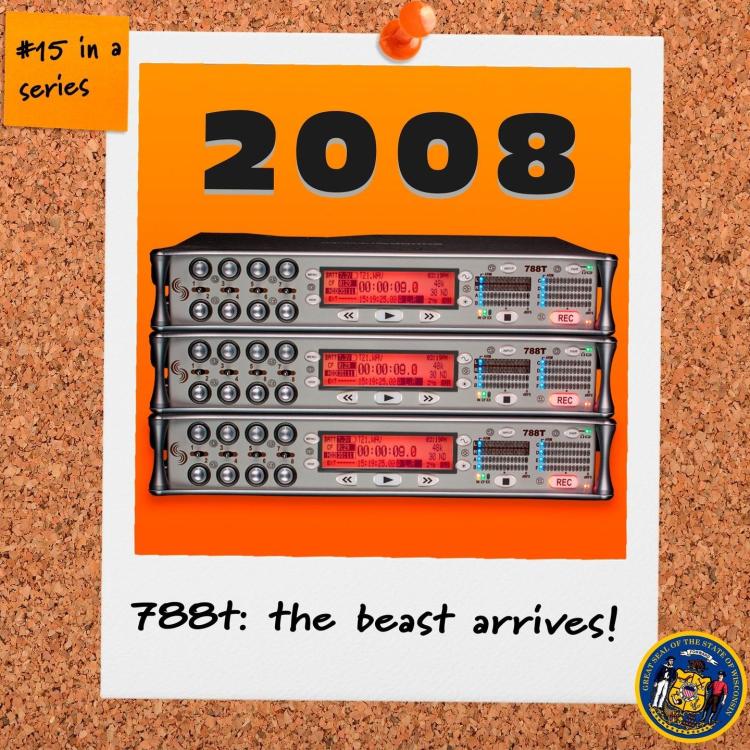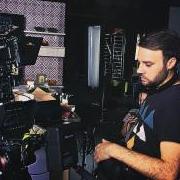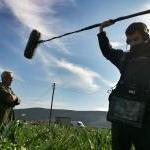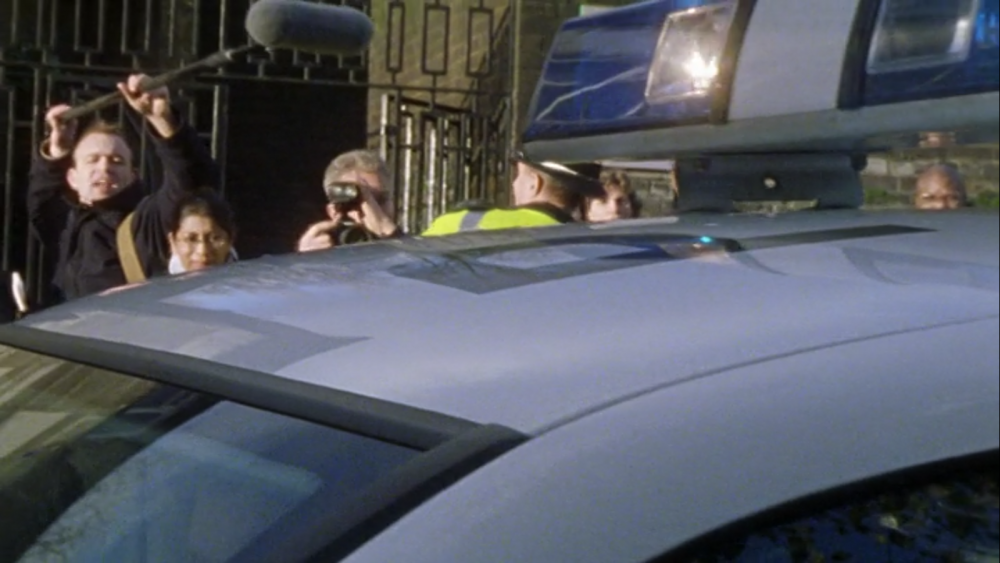Leaderboard
Popular Content
Showing most liked content since 03/16/2024 in all areas
-
Today, Halter Technical began posting a series of Reels that I hope uplifts and inspires working professionals, and those who are building their career. New episodes of #RespectSound will appear on Mondays and Fridays on Facebook, Instagram, and YouTube. I hope you'll check them out! https://www.youtube.com/playlist?list=PLKnxJ6JEwFFU9_AtlyE1IYL8b_reDjV804 likes
-
For those of us in the Lectro ecosystem: the digital successor to the SSM was just announced. https://www.gothamsound.com/product/dssm-digital-transmitter3 likes
-
The DSSM will be an excellent addition to my D2 wireless eco system. I too what would love remote control if TX’s . I’m betting that WMAS with its 6 MHz bandwidth will the be future for remote control for not only Lectro but all manufacturers in the next couple years and all those 2.4 ghz controlled systems will be outdated. And if/when we do see a WMAS compatible system with remote control Lectro’s track record shows that these D2 TX’s will most likely work with the next gen RX’s maximizing your investment.3 likes
-
2 likes
-
2 likes
-
2 likes
-
because WMAS is allowing bidirectional communication between transmitters and receivers, so in theory it can be used to control all the bodypack parameters2 likes
-
Just to be more specific At the end of the day, I give my card 1 to DIT or who’s in charge. When I'm back home or at the hotel, I make a back-up copy of card 2, and that's when I sort out and rename the wild tracks. I only send the folder with all the wild tracks at the end of the project, in one go.2 likes
-
And now I have just added part 3 of my MKH 8030 tests, probably a little more relevant here than part 2: in this case it is a series of MS tests with the MKH 8020, MKH 8040 and MKH 8050 - all field recordings/ambiences, not music. Cheers, Roland https://drbadphil.com/sennheiser-mkh-8030-part-3-mid-side-field-recordings2 likes
-
Before the topic changes completely, let me just chime in to agree with Constantin that AES42 is definitely more than just a passive interface for receiving digital audio signals. Unlike AES3 it has a control channel that runs from the interface to the microphone(s) (along the same set of wires, of course), and quite a few essential commands are predefined in the standard, such that all AES42-compatible microphones should implement them. Some other commands are "defined but optional." And there's also a range of command codes available for manufacturers to define for themselves however they want, so that unique features can be offered. What you can do in Mode 2 that you can't do in Mode 1: [a] record synchronously with any given timing signals, such as a master clock, without using sampling rate converters [b] run multiple microphones without sampling rate converters. In Mode 1 each mike is independently self-clocking, and no two are ever exactly alike.2 likes
-
There are real-world situations in which a digital microphone can offer an audibly lower noise floor than a comparable analog microphone. For years I used to think that digital microphones were just a rearrangement/refactoring of the same set of components (capsule, preamp, a/d converter) as in a digital recording setup with analog mikes, and yes, that is true for the most part. But the hitch is analog mike preamps (whether outboard or part of a mixer or recorder) and their noise levels and headroom in relation to their gain settings. Mike preamps, contrary to what some people apparently assume, are nearly all at their quietest when set to the upper range of their gain settings. If the sounds that you're recording include very high SPLs (even for brief intervals), you can't leave the gain of the preamp (or analog recorder or mixer input) set very high, or you'll clip the analog electronics. As a result, you have to set the gain for the loudest sound that you expect to pick up, which raises the noise floor for the quieter parts of whatever you're recording, compared to what that noise floor would have been at higher gain settings. Sometimes this raises the preamp's noise floor above that of the microphone or the recording environment. And that's a compromise that you don't have to make with digital microphones. As a result, every now and then people with real, professional experience find to their astonishment that digital microphones are quieter or even (as some have said) much quieter in certain recording scenarios than the comparable analog microphones had been for them before. I used to think those people were tripping--but now I realize that they could very well be describing their experience accurately, though perhaps not understanding that no, the microphones themselves aren't any quieter; it's the benefit of working without the occasional limitations of analog preamps. The effect isn't extremely common, but I think it's 100% real when it occurs. Does that explanation help? There's a video in German that Helmut Wittek from Schoeps posted on YouTube that goes into this; I could provide a breakdown of it in English if anybody wants. --best regards2 likes
-
Now that sounds sketchy to me. Yes sound is pivotal, but calling it that as part of the hiring process screams fake to me. Come to think of it, the whole thing looks like it's written by ChatGPT to me. Lots of words that say nothing.2 likes
-
Sunday, March 24 at noon Mountain Time (UTC -6) This will also be available afterward. Link:2 likes
-
2 likes
-
I'd tell them to pound sand then. What's next, you need to pay them for the catering too? If production doesn't want liability, then they shouldn't be creating a production.2 likes
-
2 likes
-
Hi all, I think it's a good idea to have one place for all news coming from NAB, including live streaming links, interesting products outside from production sound world etc. Looking forward to see what NAB has to show us this year. There will the famous party, right? Thank you, Vasileios1 like
-
We tried an earlier proto on a 17 page backwards walk and talk, it was great for that1 like
-
Neat ... that's the first armature I've seen that doesn't look totally impractical and bulky. I might keep an eye on this. It's still a pretty big item to be carrying run and gun, but they've clearly put a lot of thought into the specific needs of sound and boom. I'd try it.1 like
-
If it's the same with both mics, I think you can conclude that it is not the mics, but rather it's either the TRX, or there might be something going on with your pole's wiring.1 like
-
Constantin, the earlier Schoeps digital mike amp--introduced nearly twenty years ago--was the CMD 2. It, too, was an AES42 device, but it supported only mode 1, in which the microphone is self-clocking, which means that you can't sync your recording to a camera or house clock, or run multiple microphones, unless your recorder has sampling rate conversion built in. The CMD 42 is indeed a complete redesign--as it should be, since the components available for a project like this are worlds better than they were twenty or even ten years ago. --I need to disclose occasionally that I've done translating and editorial consulting for Schoeps for many years, and I'm subject to the human tendency toward bias. (Also equalization.)1 like
-
Yes, thnx, I already edited my post. The German Referenzhandbuch v1.32 p28 only mentions on the option for switching it on and the warning: "Manche Kondensatormikrofone funktionieren möglicherweise nicht mit einer Phantomspannung von 24 Volt. " meaning "Some Mics may not work with 24V phantom power."1 like
-
And to add, Sennheiser have given me the thumbs up to use the polar pattern now (the specs sheet will be published in conjunction with the mic appearing at NAB 2024 (13-17 April), so I have updated my original blog post on the mic accordingly: https://drbadphil.com/sennheisers-new-fig-8-the-mkh-8030 Cheers, Roland1 like
-
The HDM digital mode has good performance with only 2mW! But they do state it's something to be used in more controlled environments and with slightly reduced frequency response (20Hz-16kHz). Walk test in this video yields good results https://www.youtube.com/watch?v=phjOWKIKwzQ&t=320s&pp=ygUVbGVjdHJvc29uaWNzIGhkbSBtb2Rl1 like
-
Haha! Not seeking admiration (or, conversely, any comments about acoustic shadowing) of the odd cluster of mics for testing, but just trying to keep thread on topic. Received the draft (and probably final) spec sheet today, with the only significant addition being the polar pattern graph: I have assumed that I can't share this until publication (at launch), but have asked for clarification. In the meantime, suffice it to say that it looks just as you would hope: very much as per the MKH 30 (i.e. symmetrical, deep nulls, and with a consistent pattern across the audible frequency range). Cheers, Roland1 like
-
What does WMAS have to do with a control scheme? I mean, I get that wider bandwidth allows more to happen, but it's ultimately just a licensing scheme for wider bandwidth channels. And control takes virtually no bandwidth, so I don't see why WMAS would open up possibilities there. What am I missing?1 like
-
Um, no, I meant https://www.youtube.com/watch?v=2st7KzoEHlo starting at 24:01. This came up last August on an amateur audio forum that I sometimes participate in ("Tapers Section"), where someone had watched this video but perhaps didn't understand the German being spoken, and thought that Wittek was recommending to set analog preamps to low gain levels such as 20 dB for best noise performance, which definitely isn't right. Here's what I posted back then: > [T]he topic from about 24:00 to about 30:00 in the recorded talk is dynamic range, which takes into account both the noise floor and the maximum SPL of the signal chain. He's very concerned to compare apples with apples: the digital microphone with the analog microphone PLUS the preamp that you have to use with it [whether standalone or built into a mixer or recorder]. > As he says (ca. 26:30), the CMD 42 isn't limited by having to pump out high voltages (more electrical power) at higher SPLs, so its maximum SPL is a few dB higher than that of the CMC 6. But when you bring an analog mike preamp into the picture (ca. 27:15), the clipping point of its output becomes a much more serious limiting factor when you get near the maximum SPL of the microphone. In the slide at the point that you mentioned, he's saying (around 28:20) that you would need to limit the gain on your preamp to about 15 - 20 dB in order to avoid this overload at the maximum SPL. > He's definitely not saying that this is an optimal setting--on the contrary! His whole point is that analog preamps typically have lower input noise than the microphone's output noise only when set to higher gain levels than that, such as 30 - 35 dB. (This was shown in earlier slides, ca. 25:15 - 26:00.) Thus there exists no one gain setting for a typical analog preamp that both accommodates the maximum SPL of the microphone without clipping, and simultaneously offers the lowest noise for the quietest sounds that the microphone can pick up. If you need to record both at the very highest and the very lowest SPLs without touching any gain settings in between, the digital microphone offers a definite advantage as compared with the analog microphone--given that typical analog mike preamps can't put out 10, 20, 30 or more Volts (not that you really would want such levels to occur in practice). > But then he goes on to say two things. (ca. 28:55) "With suitable operation of the preamp, I can obtain performance from the analog system that is exactly as good, or nearly as good, as that of the digital microphone. But I must operate it in a suitable way; I must really set exactly the gain level that suits my application exactly." Secondly, (ca. 29:50) combination analog mike preamps and A/D converters exist that use multiple analog gain stages and gain ranging--and he says that such equipment can produce results that are very nearly equivalent to digital microphones. --best regards1 like
-
1 like
-
Digital Microphones..... a solution looking for a problem. Neumann dropped their Solution D series and Sennheiser has not made their digital 8000 series components in a few years. Mature analog technology is still King.1 like
-
Yeah, the Pianissimo fur is seriously thick. I mostly just use the skin without the fur unless it is seriously windy. Didn't know about the Bubblebee fur ... I'll have to look for that.1 like
-
The Cosi I have ist the standard one that is pictured everywhere. I guess from your upper quote Cinela calls that medium pile length. I called it felty because it is a bit felty out of the factory, compared to longer fur. The only one with longer fur I've ever seen was on Monday at my dealer when I checked the MKH50 holder. Maybe this is a new thing, demo unit or just a different "batch". The Cosi is very nice on the boom for before mentioned reasons. As THE standard outdoor tool it is not effective enough but only in mildly windy situations, don't quote me in Bft, IIRC the lab video demonstrates it. It is more a convienience alternative to a bigger WS. I mean the exact same thing as Cinela with "decent wind protection". Just less public relations speak. It is limited. IMHO Cinela makes superior products to Rycote (to a higher price). Get the Piani 1st, ideally with the raincover and Bubblebee fur, so you have the best there is against the elements. get a Cosi, when you saved more money to have a more sleak option. I rarely use a cardioid supercardioid outdoors and I don't know if you mainly record sound for video and a camera is around.1 like
-
Is there a more advanced interface for AES42 than what my Nova provides? How are those advanced features accessed? My understanding is AES42 is a spec for transferring digital audio (sometimes with self-power), not a control spec. Schoeps has a list of AES42 interfaces and what features are included, and most of them do not provide more than power and sample rate conversion. https://schoeps.de/fileadmin/user_upload/user_upload/Downloads/Kataloge_und_Broschueren/Prospektblaetter/AES_42_interfaces_for_Schoeps_CMD_42_and_SuperCMIT_-_Tabellenblatt1.pdf1 like
-
Nobody can say for sure 100% what may happen at some undetermined point in the future, but those bands you mentioned are of course the ones we can use in the US at this time. Which one of them would be best is depending on where you work. In a lot of areas in Los Angeles, it’s fair to say scans in B1 look busy, but you can always find a few usable frequencies. A1 looks somewhat better, but random things like EMT can show up out of nowhere and wipe you out, even when the scans looked clear 5 minutes ago. Having one block of clear freqs in 941 might of course better than having 3 congested blocks…. But again, who knows what might be best on any given day at any given location. So many variables possible, including other sound mixers nearby (or driving by). And again, who knows if that gets auctioned off at some point in the future….? So in conclusion - get one of each and you should be covered - at least for now hah!1 like
-
You can find all the latest firmware and documentations at www.cantarx.com . There is also a "Cantar X3 User Group" at facebook with all documentations and repair guides.1 like
-
I have been using these quick connect adapters on my sna antennas for about six months now. Highly recommend if you switch often between ENG and cart antenna setups. I’ve used them in mission critical jobs and it allowed flexibility to swap a bunch of antenna setups quickly. https://www.americanradiosupply.com/sma-male-female-quick-disconnect-push-on-coaxial-adapter-connectors/1 like
-
I've had some luck with Nite Ize Gear Ties. I like the fact that you can lock those, so the cable doesn't untie itself which almost always happens when you don't want it to. I've dreamed of taking my vacuum cleaner's cable winch out and putting it on my bag.. but.. weight and noise.1 like
-
Martin Mitchell, here in the UK, https://martinmitchellsmicrophones.wordpress.com/2023/08/ tried a pair of Roland CS-10EM Binaural Microphones/Earphones last August, and added a couple of recordings to his web-page. These Roland earbud mics cost only about £80 (US$100) ..and I've just seen a used pair on eBay for £60 (US$75). The quality is really good (I have a pair), but - as DocSoundGuy says - although played back thro' earbuds the sound is immersive, with over-ear cans instead, or standard loudspeakers, the effect is more dispersed, 'lighter-weight' or rather tinny. With buds stuffed in your ears, reproduction does sound as if the listener is really there, but without having that replay sound stuffed straight down your own ear canals, you miss much of the immersiveness. But they're a cheap and great way to experiment - instead of buying a Zylia 19-mic golfball!1 like
-
Getting a strap that is truly ergonomic and that weights the case properly for carrying takes some time and experimentation. I reused a strap from an old camera bag, but it constantly falls off my shoulder because of how I've attached it. It's not practical for carrying it long distance with other cases. Ideally, I need a strap that has the shoulder pad farther up (so it actually goes over my shoulder, and that is contoured and textured so it doesn't slide down. I'm sure it's doable, but it's not as simple as I'd hoped.1 like
-
in 2024 this is still not clear airport to airport. I have been flying a bunch carry-on only lately. Calling it a Fish pole or mono pod seems to work and a mono pod it is authorized for carry-on bags specifically. But it truly is up to the discretion of whoever pulls your bag aside. Total gamble and I feel a bit risky with an expensive boom pole. Oh my aluminum traveler is compact and expendable if it came down to it as I knew I could bill for a replacement in a pinch with those I travel with. I typically will add a second pool in a checked bag or in one of their SKB golf bag cases if Camera Dept I am traveling with Will allow me to1 like
-
Yes, note that Matt Price was clearing this with airline desks during baggage drop-off and before going through security. Airline practice may be unpredictable, and indeed may have changed since his video was made. Personally, I’m content with putting a pole in my checked roller bag, and I know that the Panamic Mini poles will fit in it.1 like
-
1 like
-
That is pretty impressive on headphones. Good job! I always marvel at how good binaural directionality sounds. Your in-ear rig worked well! I'm still not convinced by the effect through loudspeakers ... it sounds hollow to me, as if you were breathing into a box. But that's wearing my picky sound-guy hat ... I doubt a casual listener would object. Thanks for sharing your work!1 like
-
This is great info as i myself have been struggling with air travel and a boom pole that works for me. I have a shorty ktek aluminum traveler that i dread using but it fits my carry on1 like
-
Hi! I believe most tripods are suitable for this microphone because it is lightweight and doesn't require a lot of strength! I included a picture to show that I wanted to place it above the choir conductor, so a tall tripod is needed. However, for nature walks, a smaller and lighter one is much more convenient. Attached to the back tripod, I have a recorder, and for that, I use the Manfrotto MS0490C Carbon Nanopole Stand. The first K&M tripod is quite thick and would need a special attachment. Generally, I use the smaller tripod; I later bought the larger one for recording the choir. The Schoeps W5D Windshield is sufficient for me. I usually don't record in very strong winds. But what do you mean by "decent quality"? 😁 I meant that even those who are picky will probably be satisfied - polite and neat.1 like
-
OMG...so annoyed. After both of your responses on a lark, I did a web search for best pitch & time shift plugins and Izotope was one of the first hits. 🤦♂️. Pulled up the alt playlist with the original audio, applied the "Variable Pitch" tool, and the results were night and day. Was sitting in my toolbox the whole time. Thank you for the extra brain that I evidently needed. Cheers.1 like
-
right the phone is a bit bucket for redundancy and convenience. The m2d2 also has a headphone jack, and I'm assuming (I hope reasonably) that combined with my reasonably good headphones, will make for good mobile listening.1 like
-
I'm not quite sure what you're getting at with the frequency response chart. The M2D2 is basically a USB-C sound cart or interface so whether you write the digital file on a high-end recorder, a computer or a smartphone doesn't really matter quality-wise. It's just the already converted file that will be the same everywhere you store it. Playback quality is not the reason for using a phone, I guess. Or am I not getting something here?1 like
-
First of all, contact your state Department of Labor and file a claim. Secondly, and they'll hate this, is fill out an IRS Form SS-8 (link attached). Email this to every beverlyboy email address you have and cc everyone on the call sheets you had, especially producer/director. They WILL NOT want the IRS now making worker determinations as the penalties from Dept. of Labor are huge for non-payment. https://www.irs.gov/forms-pubs/about-form-ss-8 File that form with the IRS. And subsequently file a dispute regarding the 1099 and let bev boy know that too. Be a complete pain in their ass and encourage all the other crew to do the same. Good Luck. You should also send copies of your unpaid invoice and demand to Roku's legal department claiming copyright for unpaid product and state the you explicity do NOT release any rights to the use of your recordings as no work for hire has been effected due to non payment. Give them everybody's contact info at bev boy. That'll be fun.1 like
-
1 like

.png.279748a58a2b862b7aa5f3b84126e232.png)
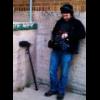


.jpg.60deb0716219777743dadbbc5c367e0c.thumb.jpg.1c9a3a88e16c9817f9ba0b039743d08a.jpg)

